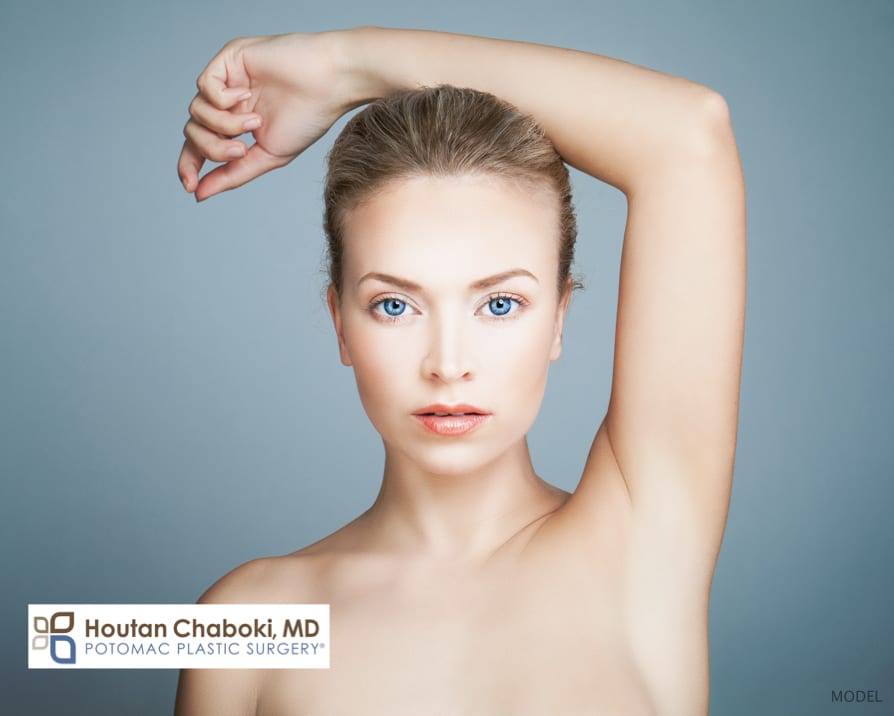
Injections of Botox can reduce underarm sweating in plastic surgery offices.
Botox® is the first thing most people know about regarding plastic surgery. It’s known to reduce wrinkles around the eyes and forehead, but it has many other cosmetic applications.
Plastic surgeons and dermatologists have been safely using Botox and other similar skin relaxers (ex. Dysport® and Xeomin®) in various areas to enhance one’s appearance. The phenomenal growth of nonsurgical liquid lift type procedures have expanded the versatility of these skin relaxers.
We’ve previously outlined some expanded uses of Botox, Dysport, and Xeomin by advanced injectors. Briefly, these skin relaxers may be used off-label to
- slim the face from excess jaw muscles
- lift the eyebrows
- lift the neck and reduce neck crease, “neffertti lift”
- reshape the nose in nonsurgical rhinoplasty from active nose muscles, “bunny lines”
- soften smoker’s lines or lipstick lines around the mouth, “granny lips”
- lift the corners of the mouth and improve a downturned smile
- smooth skin dimples of the chin, i.e. peau d’orange
- reduce a gummy smile
- relax lower eyelid “banana rolls”, due muscle bunching up that may contribute to “puffy eyelid”
- enhance hair growth
- soften scars
- shrink large salivary glands, located in the upper neck or sides of the head
Advanced injectors in plastic surgery offices also reduce excess sweating in the underarm, also known as hyperhidrosis in some patients.
What is Hyperhidrosis?
Hyperhidrosis is a condition where excess sweat occurs, which often occurs in the areas of a higher concentration of sweat glands such as the palms of the hand, soles of the feet, and underarm. Hyperhidrosis can be debilitating and lead to social embarrassment and subsequent occupational or psychological disability. There are several subtypes of hyperhidrosis, but the exact cause of hyperhidrosis remains unknown.
Excess sweating affects many people. The underarm has about 2 to 4 million sweat glands, and only about 5% are active at any one time. The potential for relatively excess sweat is present in everyone. Excess sweating can occur in many without the clinical diagnosis of hyperhidrosis. These individuals may have increased sweat production, or just want to reduce sweat for personal reasons.
How does Botox Reduce Sweating
Treatment for excess sweating usually starts with topical deodorants, antiperspirants, and aluminum salts. These topical treatments are applied to the skin and directly affect the sweat glands to stop sweat. Topical treatments are temporary, only lasting about a day or so, and typically more effective in milder cases of excess sweating. Some also report skin irritation with such topicals.
Botox, on the other hand, does not directly affect sweat glands in the skin. Rather, Botox injections help block nerve impulses that go to the sweat glands. Without nerve input, the glands become quiet and don’t express the sweat.
Botox injections to Reduce Sweat
Topical numbing cream can be used to reduce discomfort, but many patients don’t necessarily need any numbing at all. Multiple small, superficial injections in the arm pit are directed to the area of sweat glands. Botox injections take just a few minutes, and patients can go back to office immediately afterward.
Results with Botox injections, similar to forehead lines, don’t start right away. Sweat reduction develops after several days and lasts about 6 months. Patient may still need deodorant to reduce odor, but may not need antiperspirants or other topicals to reduce excess sweat. Many come about twice a year to reduce sweating, or more frequently if they have a big social event and want to take extra precaution to reduce sweating. The duration of results may become longer for those who receive repeated Botox injections over time.
Similar to other Botox injections, patients should be careful with the skin for the first day or so after treatment. Patients may wash the skin, but avoid excess rubbing of the area. Waxing or shaving should be avoided the first 2 days after Botox. Exercise should be avoided too.
Keep in mind that Botox can work really well for some, but some patients may not respond to the sweat reduction of Botox.
Other Cosmetic uses of Botox
New applications of the skin relaxers are continuously being investigated by the best aesthetic physicians. However, it hasn’t replaced plastic surgery in certain cases, as excess skin still typically requires a surgical lift.
Have you considered cosmetic procedures with nonsurgical treatments such as Botox, Dysport, or Xeomin? The best plastic surgeons use these wrinkle relaxers to help improve one’s appearance in a variety of ways. An advanced aesthetic injector, such as Dr. Chaboki, can help determine appropriate options.
Potomac Plastic surgery offers you a chance to experience non sweating underarms for a reduced price until the end of November 2018. Avoid looking nervous or stressed over the holidays due to hyperhidrosis. Restrictions apply.
Contact the office today.

Leave a Reply